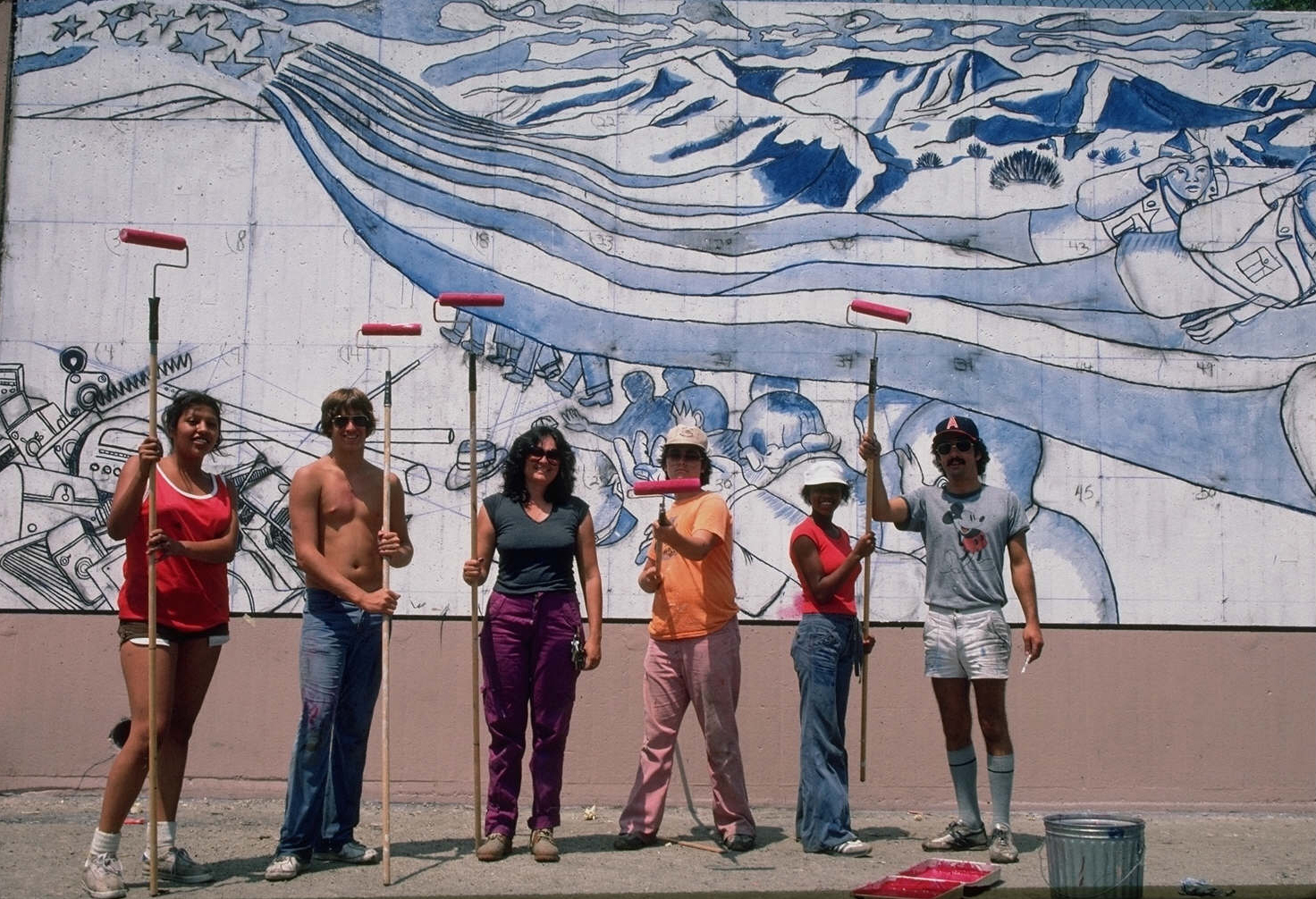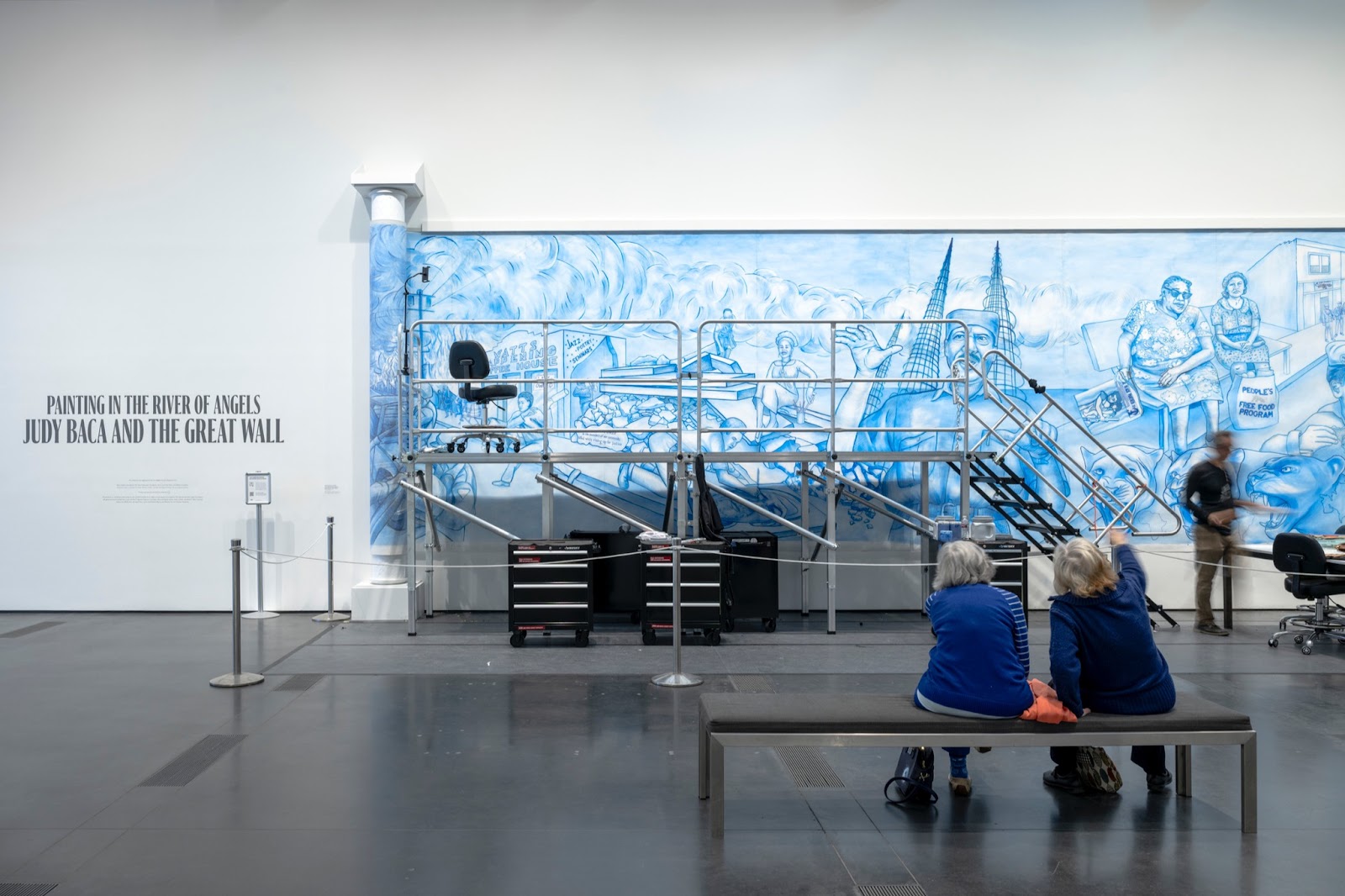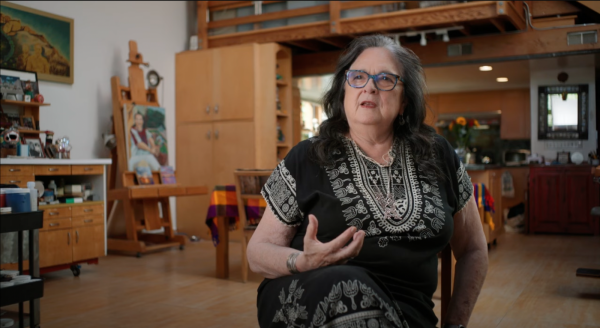When activist and artist Judy Baca conceived The Great Wall of Los Angeles in 1975 as a monument to the history and the people of California, she didn't realize that she was embarking on a 50-year journey that would employ 400 youth and community members, resulting in one of the largest murals on the planet. Baca and artists from the Social and Public Art Resource Center have now transformed the museum into a studio, painting new sections of The Great Wall in progress and on view in Painting in the River of Angels: Judy Baca and The Great Wall at LACMA.
Alongside this historic occasion, filmmakers Alejandra Vasquez and Sam Osborn recently collaborated with the artist to create Baca, a documentary exploring the history and present of The Great Wall. We spoke to them about their experience working with Baca and SPARC, the significance of public murals, and the process of bringing this essential community project to the screen. Read the conversation and watch the film below.
Could you tell us about Baca in your own words?
Baca is our attempt to distill Judy Baca’s work and philosophy into a short-form portrait centered around her landmark piece, The Great Wall of Los Angeles. SPARC, the non-profit arts organization that Judy founded, has an incredible archival trove of her work over the decades. We tried utilizing as much of that collection as possible to convey the amazing scale of time in which Judy’s been working.
We were also immediately taken with an idea that Judy often talks about: that the land holds memory. By painting a mural in a public space, you’re giving that memory new life. We really wanted to make a film that connected her murals to the land upon which they were painted.
What was your impression of The Great Wall of Los Angeles? Had you visited the mural before?
We’re somewhat new to the Los Angeles area so it was the first time that we had seen The Great Wall. The scale of it is immediately striking. It takes 15 minutes just to walk the length of it. You could spend hours absorbing it all. It’s also fascinating to see how her approach to each section’s composition changes over the years. You can kind of see the confidence and complexity of the compositions grow with each section of the wall.
That said, actually viewing the mural is less than ideal. There’s tall fencing along the viewing rail, presumably to keep folks from jumping into the concrete wash below. But it means that you’re always looking through some kind of structure to actually see the mural. We had to secure special permits to be able to enter the Tujunga Wash so that we could film the mural unimpeded. Part of the wall’s current expansion project includes renovating the surrounding pathway and park, so hopefully the city can figure out a way to display the mural without obscuring it so much.

What was it like working with and capturing Judy Baca?
It’s funny, we caught Judy at an especially busy time. She’s become so celebrated in the last several years that she seems to be juggling a dozen different projects. And through SPARC she has this wonderful team around her that kind of keeps all these huge lumbering projects moving forward. But what’s amazing is that once we were able to sit down with her a few times to film, there was a razor-sharp focus to her philosophy. And when we went back and looked at interviews that she gave almost 50 years ago, there was that same philosophy and approach to the work. But it’s not like she hasn’t grown. It speaks more to the fact that she was clear-eyed about the purpose of her work at a young age, and that her objective has stayed true throughout so many years, administrations, life changes, etc.
Was there anything that surprised you during the process of making this film?
Something we realized as we drove around the city to the sites of Judy’s murals is how few of them have been preserved. We were surprised to learn that many of Judy’s public outdoor murals—like her first mural in Boyle Heights, Mi Abuela—have been neglected or are completely gone. There’s something deeply fascinating and sad about that: cities are ever-shifting, and even if a public surface has been painted by a celebrated artist it takes a lot of political will to preserve that space indefinitely. Murals gain their power by existing in public spaces outside of the gallery or the museum, but they’re also then subjected to the same treatment as the rest of an urban environment. The good news is that the art community’s larger embrace of Judy’s work means that she can be a louder advocate for the preservation of her work in public spaces.

Do you see any similarities between filmmaking and Judy’s community engagement and mural making?
Yes and no. Judy’s work tries to actively enact change within a community. A lot of her work with The Great Wall involved getting young people out of their normal day-to-day circumstances, giving them a job and training them to paint murals. What we do is a lot more passive. We’re often saying “pretend I’m not here” and trying our best not to change a community but to instead capture it authentically.
That said, the reason we connected so much with Judy’s story is that she approached her art with a community-and-activist-oriented objective. She wasn’t looking at her work purely for its aesthetic value; there was always a tangible reason behind doing the actual work of painting. And the work itself is the point, rather than just the finished product.
What would you like viewers to take away from this film?
Murals have long been a form of political expression for artists who work outside of the traditional museum space, and there’s an especially celebrated lineage of Mexican muralists. We wanted to convey that Judy Baca is part of this lineage and that the way she has accomplished this is by engaging in her hometown community as a Chicana artist and educator. She didn’t set out to become a successor to Diego Rivera or something. She started as an educator and, with that as her north star, forged a career worthy of inclusion in that lineage of muralists. But she did it her own way.
The exhibition Painting in the River of Angels: Judy Baca and The Great Wall is on view in the Resnick Pavilion through Sunday, July 21, 2024.



